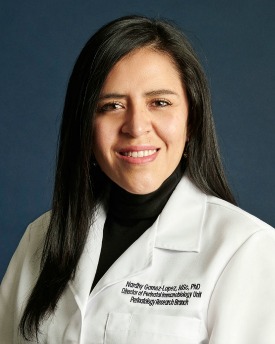
A team of Wayne State University and Perinatology Research Branch researchers have found that specialized lymphocytes, regulatory T cells, play a central role in sustaining pregnancy in the third trimester, and the loss of those cells can lead to preterm labor and birth. They also discovered that replenishing these T cells can prevent preterm birth and reverse the associated adverse outcomes in neonates.
The study, “Regulatory T Cells Play a Role in a Subset of Idiopathic Preterm Birth and Adverse Neonatal Outcomes," https://www.cell.com/cell-reports/fulltext/S2211-1247(20)30855-X is published today in Cell Reports.
“The article reports that a subset of lymphocytes called regulatory T cells are important in normal pregnancy and that a deficit in these cells results in premature labor and also adverse neonatal outcomes,” said Nardhy Gomez-Lopez, Ph.D., associate professor of the WSU Department of Obstetrics and Gynecology, and section head of the Maternal-Fetal Immunobiology Unit. She is the lead author of the study. “Our research found that the depletion of regulatory T cells during pregnancy results in abnormal placental gene expression and fetal growth restriction, but the replenishment of those cells can prevent premature labor and adverse neonatal outcomes.”
One in every 10 infants were born early (before 37 weeks) in the United States in 2018, the last year for which statistics are available. Babies born early remain at high risk for both short- and long-term health complications, resulting in an enormous societal and health care financial burden. According to the World Health Organization, an estimated 15 million babies are born prematurely annually, and approximately 1 million children die each year due to complications of preterm birth. In fact, preterm birth is the leading cause of death in children younger than 5 worldwide.
The 2019 March of Dimes annual “report card” found that the preterm birth rate in the United States worsened for a fourth year, rising from 9.63% of every 1,000 births in 2015 to 10.02% in 2018. Michigan, with a 10% rate of preterm birth, received a “C” grade, while the city of Detroit, with a 14.3% rate, received an “F.” In Michigan, the preterm birth rate among Black women is 57% higher than the rate among all other women.
The study reports that regulatory T cells, a subset of specialized lymphocytes, play a central role in sustaining pregnancy in the third trimester. A depletion of Tregs during pregnancy results in abnormal placental gene expression and fetal growth restriction, which can lead to preterm birth and its attendant adverse health outcomes.
The depletion of regulatory T cells led to spontaneous preterm birth in 15% of cases, but that effect was reversed and halted by the adoptive transfer of such cells, said Dr. Gomez-Lopez, who is also with the Perinatal Research Initiative in Support of the Perinatology Research Branch.
The researchers found that regulatory T cells are reduced in a subset of women who experience idiopathic, or unexplained, preterm labor and birth. However, the reduction of the cells does not occur in full-term labor. The imbalance of the Tregs creates a stereotypical type of inflammation, which is different from that observed in women with intra-amniotic or systemic inflammation. The authors propose that these cells play a critical role in modulating cellular responses that prevent inflammation in late pregnancy as well as prohibiting fetal growth restriction.
In addition, the team found that adverse neonatal outcomes were more prevalent when regulatory T cells were depleted in additional pregnancies, supporting the concept that pregnancy imprints a protective regulatory memory carried into further pregnancies.
View a video of the study here.
Other researchers involved in the study include Roberto Romero, M.D., D.Med.Sci, chief of the PRB; Marcia Arenas Hernandez, Ph.D., PRB research associate; Derek Miller; PRB research assistant; Valeria Garcia-Flores, assistant professor; Yaozhu Leng; PRB research assistant; Yi Xu; PRB research associate; Jose Galaz, PRB post-doctoral fellow; Sonia Hassan, M.D., professor of WSU Obstetrics and Gynecology; Chaur-Dong Hsu, M.D., chair and Frank P. Iacobell Professor of WSU Obstetrics and Gynecology; Harley Tse, Ph.D., professor of WSU Biochemistry, Microbiology and Immunology; Carmen Sanchez-Torres, professor of the Departament of Molecular Biomedicine, Centro de Investigación y de Estudios Avanzados del Instituto Politécnico Nacional, Mexico City; Bogdan Done, Ph.D., PRB post-doctoral fellow; and Adi Tarca, Ph.D., professor of WSU Obstetrics, and the Gynecology, Bioinformatics and Computational Biology Unit of the WSU School of Medicine.
The study was supported by the Perinatology Research Branch, Division of Obstetrics and Maternal-Fetal Medicine of the Intramural Program of the Eunice Kennedy Shriver National Institute of Child Health and Human Development, and the Perinatal Research Initiative of Wayne State University.
The Perinatology Research Branch, an arm of the National Institutes of Health, is dedicated to maternal-fetal research and combating preterm birth. It is the only center of its kind outside of the NIH’s Bethesda, Md., headquarters. Since coming to WSU 28 years ago, it has assisted more than 25,000 mothers.